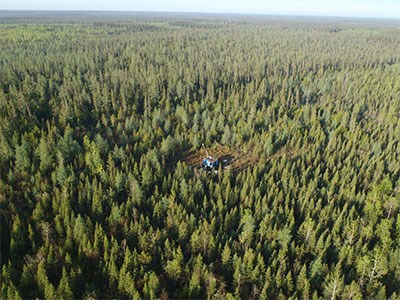Is Zenyatta Ventures’ discovery of a high-grade graphite deposit really a one-off?
That’s what Lakehead University’s Andrew Conly has been tasked to find out.
The Thunder Bay-based junior miner decided to tap into the collected wisdom of the university’s geology department back in 2011 to figure out exactly what they had found at its Albany project, 30 kilometres north of the Trans-Canada Highway near the communities of Constance Lake First Nation and Hearst.
The area had been relatively underexplored when Zenyatta came rolling through looking for nickel and copper.
Conly, a mineral deposit specialist in base metals, had no experience in graphite, but he was well-versed in the earthly mechanical processes that produce these deposits.
This was definitely something unique.
“I’d never seen anything like this,” said Conly, who examined some sections of the finely crystalized ore and “really clean looking” rock.
The formation and the discovery of the deposit, and its two breccia pipes, hundreds of metres wide, that delivered this carbon coming straight from the earth’s mantle, has often been compared to a diamond find.
“What we’re looking at here is the core to a major volcanic complex,” said Conly.
The deposit is beneath a thick veneer of about 40 metres of James Bay lowlands’ sand, gravel and limestone, so there are no telltale signs on surface.
The company claims this “rare hydrothermal or vein type deposit,” that’s 99 per cent pure, is the largest and only known graphite deposit of its type under development in the world.
There are three types of graphite deposits: flake, amorphous and hydrothermal.
Hydrothermal graphite is the purest and cleanest form there is, and it’s also very rare.
What Zenyatta uncovered with Albany is something not seen outside of Sri Lanka in more than 150 years.
This discovery has garnered Zenyatta plenty of accolades over the last two years, including being named the Discovery of the Year Award by the Ontario Prospectors Association in 2013. The company has also taken home the TSX Venture Exchange’s award for the Top Performing Company two years consecutively.
Last December, with Conly’s help, Zenyatta released a mineral resource estimate for Albany with an indicated count of 25.1 million tonnes at an average grade of 3.89 per cent graphitic carbon containing 977,000 tonnes, and an inferred estimate of 20.1 million tonnes at an average grade of 2.20 per cent, containing 441,000 tonnes.
Graphite is much in demand in the clean-tech and green-tech sectors for lithium ion batteries, the wind and solar energy industry, electronic devices and fuel cells,
If developed, Zenyatta is targeting the $13-billion global synthetic graphite market.
Conly said what Zenyatta has with Albany is a deposit with low sulphide content which generates less waste material and achieves greater efficiencies and lower costs in processing.
In separating themselves from other graphite producers, Zenyatta has taken an educational approach to ensure that whatever information they release is backed up by solid research.
“I’ve worked with a lot of exploration companies over my research career and I’ve had amazing experiences, but nothing compares to (company president-CEO) Aubrey (Eveleigh) and his team,” said Conly.
“They don’t want to put a bunch of puffery out there that we overstated something or were completely in error.”
Conly secured a federal Natural Sciences and Engineering Research Council (NSERC) grant to study the deposit and better understand its origins.
With industry and in-kind contributions, the total research project is worth almost $150,000.
The industry criticism is that this is a one-of-a-kind deposit, said Conly, “so why bothering studying it? What’s one-of-kind today might be run-of-the-mill a decade from now. Who knows? We have this unique type of graphite deposit. What are really the mechanisms of it forming and why is it there?”
He’s hopeful his research could eventually be developed into an industry exploration model.
The company has started a preliminary economic assessment to study Albany’s open pit potential. The report is scheduled for release by early summer.




